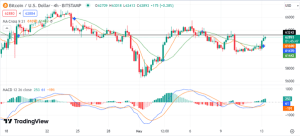Bitcoin (BTC) has seen a notable fluctuation in its price, recently surging to $62,754.69 after a brief downturn over the weekend, where it dipped to $60,000. This rebound of 2.64% in the last 24 hours has brought the cryptocurrency back into a critical phase of its trading pattern, coinciding with external market forces and macroeconomic indicators set to influence its trajectory. The market cap reflects a gain of 2.63%, reaching approximately $1.24 trillion, indicating strong market interest.

The current price movement of Bitcoin shows a test of a crucial resistance level. Looking at the recent price chart, BTC has made a recovery from a significant dip and is now attempting to stabilize above the $62,000 mark. This level is pivotal as it aligns with recent bearish trends where Bitcoin struggled to maintain its ground, risking a further drop to lower support levels around $60,000, which market analysts have suggested could trigger broader sell-offs.
Market sentiments are mixed, with optimism fueled by recent price recoveries and the potential end of the post-halving “Danger Zone,” as noted by crypto analysts. However, there remains a cautious stance among investors due to the potential for sharp declines if Bitcoin fails to maintain its current support levels. The next few trading sessions are critical for Bitcoin as it contends with significant economic updates and its ability to hold a steady course above the crucial $62,000 threshold.
Bitcoin Volume Surge Amid Economic Uncertainty: Analysts Eye Potential Market Impact
BTC’s volume has increased sharply by 91.65%, amounting to $24.75B over the last 24 hours. This surge in trading volume might be a reaction to upcoming macroeconomic updates, such as U.S. inflation data, which traders are closely monitoring. Such economic indicators are crucial as they could influence the Federal Reserve’s decisions on interest rates, thereby impacting Bitcoin’s appeal as a hedge against inflation.
Further complicating Bitcoin’s outlook are broader mrkaydnamics and macroeconomic indicators. U.S. economic data has shown signs of slowing, which could influence the Federal Reserve’s monetary policy decisions. With upcoming U.S. inflation readings, including the Producer Price Index (PPI) and Conet sumer Price Index (CPI), market participants are closely monitoring potential impacts on Bitcoin’s price. The CME’s FedWatch tool indicates a 24.6% chance of a rate cut at the July Federal Open Market Committee (FOMC) meeting, which could bolster bullish sentiment if confirmed.
Additionally, the broader crypto market reflects a mix of cautious optimism and underlying anxiety. The CoinDesk 20 index, a measure of the largest cryptocurrencies excluding stablecoins, recently increased by 2.42%, indicating some resilience. However, Bitcoin’s precarious position around the $60,000 threshold has analysts like Alex Kuptsikevich of FxPro warning of a potential sharp decline that could trigger widespread selling pressures.


